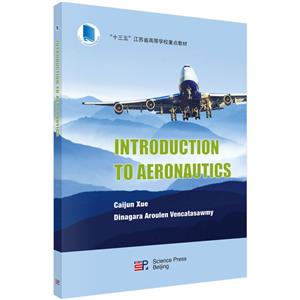-
>
公路車寶典(ZINN的公路車維修與保養秘籍)
-
>
晶體管電路設計(下)
-
>
基于個性化設計策略的智能交通系統關鍵技術
-
>
花樣百出:貴州少數民族圖案填色
-
>
山東教育出版社有限公司技術轉移與技術創新歷史叢書中國高等技術教育的蘇化(1949—1961)以北京地區為中心
-
>
鐵路機車概要.交流傳動內燃.電力機車
-
>
利維坦的道德困境:早期現代政治哲學的問題與脈絡
航空概論(英文版) 版權信息
- ISBN:9787030698896
- 條形碼:9787030698896 ; 978-7-03-069889-6
- 裝幀:一般膠版紙
- 冊數:暫無
- 重量:暫無
- 所屬分類:>
航空概論(英文版) 本書特色
適讀人群 :國內幾個有航空航天類專業的高校針對來華留學生,我校國內大學生?該書是目前國內唯一一部英文航空概論教材,與國外類似教材相比,章節安排方面更加適應我國高校留學生培養方案。
航空概論(英文版) 內容簡介
系統扼要地介紹航空科學技術基礎和重要的知識,主要包括6部分內容:航空發展史、空氣動力學基礎、航空器飛行原理、航空發動機、航空器結構基礎、航空儀表及導航等;《航空概論(英文版)》也介紹了航空器一些新的技術進展。
航空概論(英文版) 目錄
航空概論(英文版) 節選
Chapter 1 History of Aeronautic 1.1 Evolution from Wheel to Space Most people today have a very little understanding of how traveling was challenging in ancient times and take for granted the very means of travel available to them. One could imagine how different life would be if man had never tamed that first wild horse, or shaped that very first wheel. How did our ancestors think about these life-altering ideas? Where did those instincts come from? How time led humanity from the ground to the stars? The history of aviation has extended over more than two thousand years, from the earliest forms of aviation, kites, and attempts at tower jumping, to supersonic and hypersonic flight by powered heavier-than-air jets. Kite flying in China dates back to several hundred years BC and slowly spread around the world. It is thought to be the earliest example of man-made flight. Some kites in China were capable of carrying a man into the air. The ancient Chinese also invented hot-air lanterns and bamboo-copter toys with spinning rotors. Archaeologists believe that the very first step toward man-made carriage began in either Mesopotamia or Asia, sometime around 4000–3500 BC, with the invention of the wheel. Man had already learned how to train horses by this period, and they were used to till the soil and plant crops. The invention of the wheel eventually created man’s ability to transport his crops from one place to another, where it gave birth to the idea of trade and exchange, and thus leading to the development of bulk transportation. The next evolutionary step of humankind was the invention of the cart. The two-wheeled cart was invented by the Sumerians around 3500 BC and it is believed to be the world’s first form of wheeled carriage. With time, this chariot evolved to the four-wheeled cart, which resolved the issues of carrying supplies and equipment. As man overcame the boundaries of land travel, his curiosity about exploring the world’s frontier became imminent. Even before the taming of the horse, man had already developed a way to travel on water. The dugout boat is one of history’s great mysteries due to its unknown origin. Historians are unable to identify when or where the very first water vessel was set afloat, and even speculate that it might have been purely an accidental creation. Fortunately, the development of the boat led to a change to the phase of transportation due to its ability to allow man to cross continents for the first time ever without the thought of dying. Over time, simple boat also known as a sail consisted of a large piece of cloth mountedon a central pole, transforming the boat into a sail-propelled ship. This new invention contributed to the ability to use rivers and oceans as a means of instant travel from one place to another against the current. Man kept expanding this horizon due to its vast exploitation possibilities and its potential in the future. Ships would eventually take on sleekness as they increased in size. Not long after, ship increased in size where oars, rudders, and deck covers were added. By Greek and Roman times, ships had grown clunky shipboard towers as well, which developed, over time, into the medieval forecastles. By the late medieval era, these castles were built solid as a part of the ship’s basic structure. Then, by the Renaissance and the Age of Exploration which followed, ships had gained tiers of rigging and sails, becoming sleek and speedy. In the 1800s, ships began to shed their sails on the rivers once again. The advent of automation was changing transportation forever. The very first automation in ships was the cumbersome paddlewheel. Due to their bulky form and inability to turn easily, paddlewheel boats were limited to river travel, where they would experience smoother currents and need less maneuverability. Zheng He was a Chinese mariner, explorer, diplomat, and fleet admiral, who made the voyages collectively referred to as the travels of “Zheng He’s Voyages to the Western Ocean” from 1405 to 1433. The invention of steamship came just after the paddlewheel that these vessels used burning coal or wood to boil water to create steam. This pressure created due to the boiling water was used in turn to move the pistons of the engine to enable sailing of the ship. The steamship was utilized to enjoy a long and safe ride on both rivers and seas. Then, in 1912, the first diesel-powered ship, the Danish Selandia, was launched. That diesel engine design was made to fulfill the industrial and military standards until after World War II. Then, in 1958, the first nuclear-powered ship was conceived. However, nuclear power was soon cast-off by industry as being too expensive and risky, though it would continue to find its use in the military community. The steam engine was a significant creation that became an automotive standard and a landmark for mass transit by land during the eighteenth century. However, these
- >
苦雨齋序跋文-周作人自編集
- >
大紅狗在馬戲團-大紅狗克里弗-助人
- >
月亮虎
- >
伊索寓言-世界文學名著典藏-全譯本
- >
羅曼·羅蘭讀書隨筆-精裝
- >
企鵝口袋書系列·偉大的思想20:論自然選擇(英漢雙語)
- >
中國歷史的瞬間
- >
詩經-先民的歌唱
















